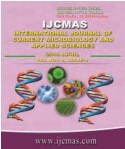


 National Academy of Agricultural Sciences (NAAS)
National Academy of Agricultural Sciences (NAAS)

|
PRINT ISSN : 2319-7692
Online ISSN : 2319-7706 Issues : 12 per year Publisher : Excellent Publishers Email : editorijcmas@gmail.com / submit@ijcmas.com Editor-in-chief: Dr.M.Prakash Index Copernicus ICV 2018: 95.39 NAAS RATING 2020: 5.38 |
The bacteria in ruminant animals help to digest the food and produce copious amounts of carbon dioxide and methane in the process. So, to know the effect of feed on CO2 emission from rumen of he-buffalo the study was conducted at 4 different feed concentration at two different draught levels at 3 hour of exercise on treadmill having speed of 2 km/h and 3 hour of rest period under maintained environment controlled chamber. The environment temperature and relative humidity was maintained according to the average temperature and relative humidity of the area which was 25oC and 90%. Two draught levels of 10% and 12% of body weight were selected. The study shows decreasing CO2 concentration in exhaled air of test he-buffalo with increase in duration of exercise and also with increase in level of draught and it shows increasing trend with the increase of berseem percentage in feed. The maximum concentration of CO2 is 75.60% at 10% draught level and at 75% berseem concentrated feed on dry matter basis during initial hour (o h) of exercise. Minimum concentration observed is 69.77% at 12% draught level after 3rd h of exercise and when 100% wheat bhusa on dry matter basis was used as feed. CO2 concentration of test he-buffalo shows increasing trend with increase in duration of rest. The maximum concentration of carbon dioxide is 76.59% which is at 10% draught (at 3rd hour of rest period) and at 75% berseem concentrated feed on dry matter basis. Minimum concentration observed is 72.26% at 12% draught level after 1st hour (initial hour) of rest and at 100% wheat bhusa on dry matter basis was used as feed.
 |
 |
 |
 |
 |